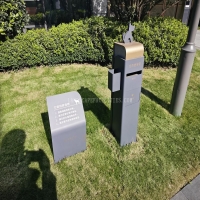Welcome to the website for landscape facilities products and knowledge.
How do landscape bar counters handle the placement of outdoor curtains or privacy screens?
Integrating outdoor curtains or privacy screens into landscape bar counters requires careful consideration of both functional and aesthetic elements. Professional installers typically employ several strategic approaches to ensure these features withstand outdoor conditions while maintaining visual appeal.
The most common installation method involves mounting aluminum or stainless steel tracks to the bar counter's overhead structure. These tracks allow curtains to glide smoothly while providing resistance to moisture and temperature changes. For permanent privacy screens, many designers opt for built-in recessed channels within the counter's construction, creating a seamless integration that appears custom-built rather than added on.
Material selection proves crucial for outdoor applications. Solution-dyed acrylic fabrics have become the industry standard for curtains due to their exceptional fade resistance and water-repellent properties. For privacy screens, powder-coated aluminum louvers or teak panels offer durability against weather elements while requiring minimal maintenance. The material choice often depends on the primary function—whether for wind protection, sun shading, or visual privacy.
Structural considerations must account for environmental factors. In windy locations, professionals recommend installing retractable systems with weighted hems or magnetic bottom bars that prevent excessive flapping. For coastal areas, stainless steel hardware with marine-grade coatings prevents salt corrosion. The integration often includes hidden wiring within the counter structure for LED lighting that illuminates the space after dark.
Height and movement patterns require particular attention. The standard approach involves mounting curtains approximately 12-18 inches wider than the bar counter on each side to provide adequate coverage when closed. Bi-fold or accordion-style privacy screens work well for corner bars, while vertical roller systems suit narrow spaces. Many high-end installations now incorporate motorized systems hidden within the counter's framework, allowing operators to adjust privacy levels with remote controls.
Drainage integration represents a critical but often overlooked aspect. Properly installed systems include gutters or drainage channels within the counter design to prevent water accumulation behind fixed screens. For curtain installations, counters should slope slightly away from the mounting points to direct rainwater runoff away from seating areas.
Maintenance access must be designed into the system from the beginning. Smart installations include removable panels in the counter structure or track systems with quick-release mechanisms for seasonal storage or fabric replacement. This foresight extends the lifespan of both the bar counter and its privacy features.
The final design consideration involves balancing privacy with atmosphere. Many successful installations incorporate sheer outer layers for wind protection with opaque inner panels for true privacy. This layered approach allows bars to adapt to different times of day and weather conditions while maintaining the open-air ambiance that makes landscape bars appealing.
Through proper material selection, structural integration, and operational planning, outdoor curtains and privacy screens become organic extensions of landscape bar counters rather than afterthought additions. The most successful implementations enhance both functionality and aesthetics while standing up to the demands of outdoor hospitality environments.
Related search:

Recommendation
Outdoor cat and dog feces trash can; Community pet trash can; Metal multi-color design